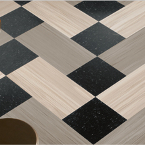 Armstrong , the leader in design and manufacturing of hard surface flooring, is the only North American manufacturer to date with polyester composition flooring products that meet the newly announced ASTM F2982 "Standard Specification for Polyester Composition Floor Tile. "
Armstrong , the leader in design and manufacturing of hard surface flooring, is the only North American manufacturer to date with polyester composition flooring products that meet the newly announced ASTM F2982 "Standard Specification for Polyester Composition Floor Tile. "
“The specification sets forth an explicit set of compositional and performance requirements that flooring tile must meet. This helps ensure that flooring tiles covered by the specification will be manufactured to consistently meet the customer's needs and the stringent demands of commercial environments,” said Tom Erisman, chairman of ASTM Subcommittee F06.80 and a senior research scientist at Armstrong World Industries. Primary users of the specification include flooring manufacturers producing polyester composition floor tiles and their customers, including interior designers, architects, facility managers, specifiers and end-users.
ASTM International flooring specifications did not previously cover polyester-based composition floor tile.
The development of Armstrong’s BioStride® polymer used in the company’s BioBased Tile®, in STRIATIONS BBT® and MIGRATIONS® products, helped drive this new category of flooring and the development of this new specification.
“Development of the Armstrong polyester binder followed important principles of green chemistry, life cycle assessment, and Design for the Environment,” said Erisman. “The product provides a PVC- and phthalate-free alternative to vinyl composition tile (VCT) for building spaces in education, healthcare, retail, office and other commercial/institutional segments.”
“Our BioBased tile is a result of our ongoing commitment to researching and developing products that have reduced environmental impact while improving performance. These innovations increase the selection of products that meet the cost, performance, and environmental criteria of our contract customers,” said Julianne Pierce, Armstrong Director of Marketing & Design.
A portion of Armstrong’s polyester binder is BioBased, derived from rapidly renewable, domestic corn, resulting in reduced reliance on fossil fuels. This product is composed of 85% North American limestone, an abundant natural resource, including 10% pre-consumer recycled content (recycled limestone). In addition to the enhanced range of environmental benefits, BioBased Tile products meet and exceed performance over standard vinyl composition tile. They have more than 5 times greater impact resistance and 2-1/2 times greater resistance to cracking from uneven subfloors than standard composition tile – all at an affordable cost.
Additionally, the BioBased Tile collection offers CONTINUUM® Color + Design, a tonal step system that designers and specifiers can employ to coordinate across designs, colors, categories, and collections to create a multitude of interior space options.
All Armstrong® resilient products are FloorScore™ certified to California Standard Method V1.1-2010. Many Armstrong products, like BBT, can contribute to LEED® credits EQ4.3, MR4.0, MR6.0 and depending on project location, MR5.0. Armstrong’s BioBased Tile® (BBT®), VCT, LVT, and Linoleum, the original sustainable floor product, have also been awarded NSF/ANSI 332 Gold Level Certification.
ASTM F2982 Specification for Polyester Composition Floor Tile was developed by Subcommittee F06.80 on Specifications, part of ASTM International Committee F06 on Resilient Floor Coverings. ASTM F2982 covers polyester composition floor tile for use in commercial, light commercial or residential flooring applications. Tile covered by the specification may be either smooth or embossed. Among the requirements detailed in ASTM F2982 are materials and manufacture information, mechanical properties and dimensions/permissible variations. The Performance Requirements section of the standard covers deflection; dimensional stability; resistance to chemicals, heat and light stability; and static load limit.
For more information, visit www.ASTM.org or www.armstrong.com.
Source: Armstrong






Have something to say? Share your thoughts with us in the comments below.